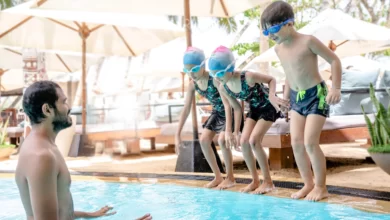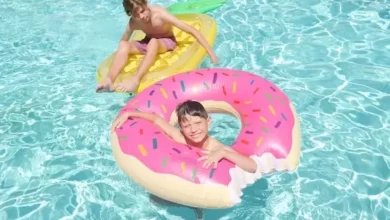Mastering the Strokes: Advanced Swimming Techniques for Adults
Swimming is not just a basic skill; it’s an art. As adults, taking your swimming prowess to the next level is an exciting and rewarding journey. In this comprehensive guide, we’ll explore advanced swimming techniques, addressing common questions to help you refine your strokes and enhance your aquatic experience.
In this article,
How Can I Improve My Freestyle Techniques to Swim Faster and More Efficiently?
- Focus on body position:
- Achieve a straight, horizontal line from head to toe by engaging your core muscles.
- Minimize resistance and drag by keeping your body streamlined.
- Enhance arm movements:
- Practice the “catch-up” drill, emphasizing the pull phase of the stroke.
- Cultivate a high elbow catch to enhance the efficiency of each stroke.
- Bilateral Breathing:
- Develop the skill of breathing on both sides to ensure a balanced stroke.
- Incorporate bilateral breathing into various swim sets to enhance adaptability.
What Are the Key Elements of a Powerful Butterfly Stroke Techniques?

- Master the Dolphin Kick:
- Strengthen your core and legs through targeted exercises to power up your dolphin kick.
- Devote practice sessions to refining the technique and improving flexibility.
- Coordinate Movements:
- Achieve synchronization between your arm and leg movements for a seamless butterfly stroke.
- Focus on maintaining an undulating body motion to maximize propulsion.
- Strengthen Core Muscles:
- Integrate core-specific exercises such as planks and leg raises into your dryland training.
- A robust core is fundamental for maintaining form and power during the demanding butterfly stroke.
How Can I Develop Endurance for Longer Swims?
- Interval Training:
- Alternate between high-intensity sprints and longer, steady swims to build both speed and endurance.
- Gradually extend the duration of your steady swims as your cardiovascular fitness improves.
- Controlled Breathing:
- Practice rhythmic breathing patterns to optimize oxygen intake.
- Experiment with different breathing techniques during workouts to find what suits you best.
- Consistent Sessions:
- Establish a regular swimming routine to enhance cardiovascular endurance systematically.
- Consistency in training is paramount for building and maintaining endurance over the long term.
What Techniques Can Help Improve My Backstroke Techniques?

- Rhythmic Flutter Kick:
- Focus on maintaining a steady flutter kick and generating consistent propulsion.
- Utilize kickboards for targeted flutter kick drills to refine your technique.
- Arm Stroke Refinement:
- Ensure a complete arm extension during each stroke to maximize reach.
- Perfect the hand entry to minimize resistance and maintain efficiency.
- Drills for improvement:
- Integrate specific drills like “catch-up” and “thumb slide” into your training regimen.
- These drills isolate and target key aspects of the backstroke, facilitating incremental improvement.
How Can I Overcome Fear of Deep Water to Master Treading Water?
- Gradual Exposure:
- Initiate your journey in shallow waters and progressively venture into deeper areas.
- Allow yourself time to acclimate to the buoyancy of deep water gradually.
- Floating Practice:
- Spend dedicated time floating on your back to build comfort and confidence.
- Gradually transition to deep water, maintaining a relaxed and controlled float.
- Seek Guidance:
- Consider enrolling in adult swimming classes or hiring a coach specializing in overcoming fears.
- Professional guidance provides structured support, helping you navigate and conquer any apprehensions.
What Drills Can Help Improve Breaststroke Efficiency and Speed?

- Kickboard Breaststroke:
- Employ a kickboard to isolate and refine your breaststroke kick.
- Focus on a powerful and streamlined kick to enhance propulsion.
- Breaststroke Pull Drills:
- Practice breaststroke pull drills to strengthen your arm movements.
- Emphasize the out-sweep and in-sweep phases for optimal efficiency.
- Timing Exercises:
- Work on the timing between your arm pull and kick to achieve a smooth and efficient stroke.
- Incorporate timing-focused drills to synchronize your movements.
Overcoming Plateaus: How Can I Break Through Skill Plateaus in Swimming?
- Vary Your Workouts:
- Introduce variety into your training routine to prevent monotony and stimulate progress.
- Include different strokes, drills, and intensities to challenge your body.
- Set Realistic Goals:
- Establish achievable short-term and long-term swimming goals.
- Regularly reassess and adjust your goals to align with your evolving skill level.
- Technique Refinement:
- Periodically revisit the fundamentals of each stroke to identify and correct any flaws.
- Consider seeking feedback from coaches or experienced swimmers for valuable insights.
What safety measures should adults take when engaging in open-water swimming?

- Know the Conditions:
- Familiarize yourself with the water conditions, including currents, tides, and potential hazards.
- Stay informed about weather forecasts and be cautious of changing conditions.
- Use Bright Swim Caps:
- Opt for brightly coloured swim caps to enhance visibility to boaters and fellow swimmers.
- Improved visibility reduces the risk of accidents in open water.
- Swim with a Buddy:
- Whenever possible, swim with a companion or within sight of other swimmers.
- The buddy system enhances safety and provides assistance in case of emergencies.
What Dryland Exercises Can Complement Advanced Swimming Training?
- Core Strengthening:
- Incorporate core exercises like planks, Russian twists, and leg raises into your dryland routine.
- A strong core contributes to stability and power in the water.
- Resistance Training:
- Include resistance exercises to target muscle groups used in swimming, such as lat pulldowns and shoulder presses.
- Resistance training improves strength and endurance for better performance.
- Flexibility Work:
- Dedicate time to stretching and flexibility exercises to maintain joint mobility and prevent injuries.
- Yoga or Pilates can be beneficial for improving overall flexibility.
How can I transition from pool swimming to open-water competitions?
- Gradual Exposure:
- Gradually acclimate to open water by participating in supervised swims in controlled environments.
- Practice sighting techniques to navigate effectively in open water.
- Simulate Race Conditions:
- Incorporate race simulations into your training, including mass starts and buoy turns.
- Simulating race conditions helps prepare you mentally and physically.
- Open Water Swim Clinics:
- Attend open-water swim clinics or seek guidance from experienced open-water swimmers.
- Learning from seasoned swimmers provides valuable insights and prepares you for the unique challenges of open water competitions.
Conclusion
Embark on your journey to master advanced swimming techniques with confidence and dedication. Whether aiming for competitive success or personal satisfaction, refining your strokes and embracing new challenges will make your swimming experience both fulfilling and exhilarating. Dive in and enjoy the transformative power of advanced swimming!

How Can I Improve My Underwater Dolphin Kick for Competitive Swimming?
Underwater Streamline Drills:
Practice streamline drills to optimize your body position during underwater kicks.
Focus on reducing drag and maintaining a streamlined shape to maximize efficiency.
Leg Strength Exercises:
Incorporate leg strength exercises like flutter kicks and vertical dolphin kicks.
Strong leg muscles contribute to a powerful dolphin kick for faster underwater propulsion.
What Are Some Advanced Breathing Techniques for Freestyle Swimmers?
Bilateral Breathing:
Develop the ability to breathe on both sides to ensure balanced muscle engagement.
Bilateral breathing enhances stroke symmetry and can be crucial for open water swims.
Rhythmic Breathing Patterns:
Experiment with rhythmic breathing patterns to find a breathing cycle that suits your stroke rhythm.
Maintaining a consistent breathing pattern contributes to better oxygen intake and overall swim efficiency.



